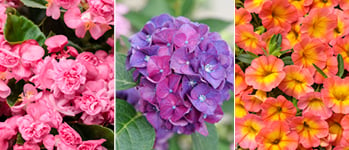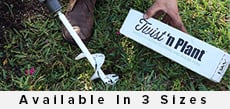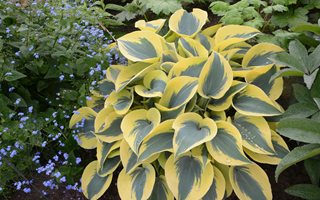Hosta Growing Guide - Care, Planting, & Design Ideas
The ultimate easy-to-grow foliage plant, hostas offer versatility, durability, and a wide variety of forms, sizes, and colorsHostas are popular foliage plants known for their tolerance of shady areas, but they do require some sunlight. Sometimes called funkia or plantain lily, hostas are attractive, easy-care, long-lived perennials providing garden interest from spring to fall. They offer a range of sizes, leaf shapes and colored foliage, as well as spikes of purple or white bell-like hosta flowers that are sometimes fragrant.
2024 Hosta of the Year:
On this page: Basics | Care | Planting | Varieties | Seasonal Calendar | Design Ideas | Common Problems
On this page:
- BASICS
- HOSTA CARE
- PLANTING HOSTAS
- HOSTA VARIETIES
- SEASONAL CALENDAR
- DESIGN IDEAS
- COMMON HOSTA PROBLEMS
HOSTA BASICS
Zones:
3-9
Height/Spread:
Mature plant size varies from 6 to 8 inches tall and 18 to 24 inches wide, to 48 inches tall and 6 feet wide, with many sizes in between.
Exposure:
Dappled or partial shade; all hostas need some sunlight. Blue, green, and variegated hostas will do better in slightly deeper shade, while yellow and gold ones need more light to bring out their colors. Those with more substantial foliage can tolerate full sun in cooler zones, if given enough regular water.
Foliage:
Varies; smooth, veined, waxy, cupped, heavily puckered, ruffled, or curled and twisted. Choose from a wide variety of hosta leaf colors, patterns and shapes:
- Shades from apple green to dark spruce, sunny yellow, grayish-blue, and blue-green leaves
- Variegated with white or gold edges or centers
- Shapes from long and narrow to wide and heart shaped
CARING FOR HOSTAS
Watering:
Keep consistently moist. Add mulch to help reduce fluctuations & avoid dry conditions. Water deeply to encourage the roots to grow further down into the soil. Those exposed to more sun will require more water.
Division:
It often takes four to five years for plants to mature, and division usually isn't necessary before this time. When dividing hostas in spring, wait for the "eyes" to pop out from the soil so you can distinguish how many there are and where to make a cut. If you divide in fall, make sure you give the roots enough time to reestablish before cold weather.
Deer:
Deer devour hostas; regular use of different repellents can help, or install deer fencing.(Learn more about how to keep deer away.)
Slugs and snails:
The best prevention is to remove weeds and decaying leaves from around hostas. Consider varieties such as 'Hudson Bay' or 'Wheee!', from the Shadowland® series, that have thicker leaves, giving them better slug resistance.
Containers:
When growing hosta plants in pots, drainage is crucial. Make sure the container has drainage holes and that the potting mix you use promotes drainage. Water container-grown plants more frequently and bring them into the garage or another protected place for the winter. Learn more on how to get rid of slugs and snails.
PLANTING HOSTAS
When to plant:
Plant in spring when new shoots appear. This is also a good time to divide and transplant established clumps. However, early fall is also an option, especially if you want your plants to look more established come spring.
Where to plant:
Generally, hostas prefer to be out of direct sunlight. Most will tolerate morning sun, but need shade during the hottest part of the day. They are often planted beneath trees, but don’t like competition from shallow-rooted trees.
How to plant:
Dig a wide planting hole, as hosta roots can grow to one foot deep and two feet wide. Untangle the plant’s roots and rest them atop a mound of soil created in the center of the hole. Backfill and water thoroughly. Bare root plants should be soaked for several hours before planting to rehydrate the roots.
Soil:
Hostas grow best in good loamy soil that is enriched with organic matter, such as compost.
HOSTA VARIETIES
SEASONAL CALENDAR
Spring:
Hosta shoots emerge in early spring, with the leaves unfurling a few weeks later and reaching their mature size by late spring (the process takes 6-8 weeks in total).
- A good time to divide and transplant hostas
- Apply a slow-release fertilizer
- Begin slug control and spray deer repellent
- Protect shoots from late freezes with cloth, pots, newspaper, or extra mulch
- Examine for signs of Hosta Virus X (see below for more information)
Summer:
Most hostas bloom in mid- to late summer, for about 3 weeks. After flowering, new buds begin forming at the base for next spring.
- Watch for leaf margins turning brown, a sign of hosta scorch
- Don’t allow soil to dry out; this can cause heat dormancy or dry rot
- Cut back on watering at the end of summer to encourage dormancy
Fall:
Hosta greenery begins to die back in response to frost, first turning gold, then drying out and drooping.
- Cut back leaves and flower scapes
- Clean up debris around plants and apply mulch
- Water well prior to the first freeze
Winter:
Plants enter a winter dormancy, leaves drop and plants appear lifeless. During this time, the roots are storing energy for spring.
- Water occasionally if you live in a dry winter climate
- Re-cover with mulch if exposed by frost heave
- Wait for them to return in spring
HOSTA GARDEN DESIGN IDEAS
The wide range of sizes among hosta plants inspires a variety of uses, from a striking focal point to edging or ground cover. Hostas contribute the all-important element of texture to a garden, and a collection with varying foliage colors and shapes is visually interesting even without flowers.
Ideas for using hosta plants in your garden:
- Bold-leaved hostas provide contrast to lacy plants such as ferns and astilbe, or linear foliage such as sedges or liriope.
- Keep things in proportion—supersized Shadowland® 'Empress Wu' will overshadow a small fern.
- Pair with summer-dormant plants such as Virginia bluebells to provide long-lasting interest.
- Hosta leaves are great additions to a bouquet or foliage arrangements.
- Use larger hosta leaves as placemats for alfresco meals.
- Hostas with white-variegated leaves or white flowers, like Shadowland® Etched Glass make great additions to a moonlight garden.
What to plant with hostas: Many plants grow well with hostas, such as: spring bulbs, ferns, wildflowers, astilbe, golden hakone grass, lungwort, bugloss, bleeding heart, euphorbia, and hellebores.
COMMON HOSTA PROBLEMS
Hosta Virus X causes mottled leaf coloring, brown spots, or leaves that appear lumpy twisted. It is spread from one plant to another by contaminated tools or hands, so always clean and sterilize tools. Infected plants should be disposed of, not composted. Learn more from Missouri Botanical Garden.
Hosta scorch causes leaves to turn yellow and crispy at the edges. Plants grown in full sun and poor soil are more susceptible. Protect hostas from intense sunlight, especially during the heat of midday and water early in the day. Remove scorched leaves and consider transplanting to a shadier location in your garden.
Frost damage can affect hosta plants during early spring. Plants will appear limp and crinkled. If frost is in the forecast, cover your hostas and water well. Remove any frost-damaged foliage as it is susceptible to diseases. Plants will often produce a second flush of leaves after frost damage.
Foliar nematodes are tiny roundworms that invade the tissue of hosta leaves, creating yellow and brown discoloration between leaf veins. Foliar nematodes spread primarily via water, but can also be transferred between plants by unsterilized garden tools. To prevent their spread, avoid overhead watering and sanitize your tools. Infected plants should be destroyed; do not compost.
Last updated: August 20, 2021
RELATED:
20 Great Shade Plants
21 Low-Maintenance Plants
Foliage Plants
Creating a Shade Garden


















